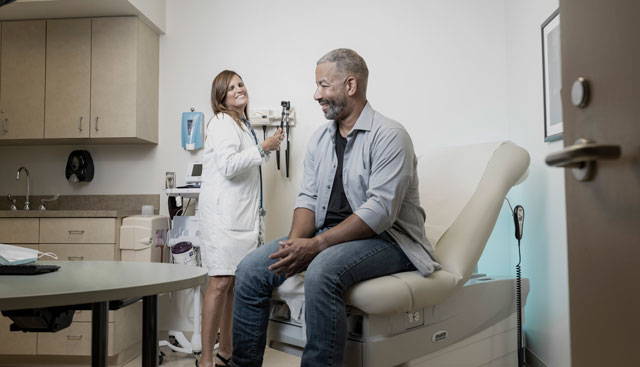
6 Common Bone Marrow Transplant Misconceptions for Leukemia Patients
Moffitt Cancer Center has the largest and most active blood and marrow transplant program of its kind in Florida and the Southeast. Our Bone Marrow Transplant and Cellular Immunotherapy team often come across misconceptions that may prevent eligible patients being considered or referred. If you have a patient with leukemia or hematologic malignancy but you are unsure is eligible for bone marrow transplant we encourage you to review some of these most common myths with Dr. Hany Elmariah of our BMT CI Program:
- Myth #1: My patient's acute myeloid leukemia (AML) is in remission, so they can skip the transplant.
Remission is not a reason to skip the transplant. While induction chemotherapy AML starts with chemotherapy to get the disease into remission. However, there still remains a risk of relapse. Depending on the specific characteristics of the AML, an allogeneic transplant is the preferred therapy. Prior studies have shown that allogeneic transplant improves long term disease free survival and increases rate of cure for high risk AML patients.
- Myth #2: My patient is too old for an allogeneic bone marrow transplant.
There is no strict age cutoff for eligibility for an allogeneic bone marrow transplant. Conditions that commonly require transplant, like acute myeloid leukemia and myelodysplastic syndrome, typically affect patients who are in their 60s or 70s. Clinical trials have shown that allogeneic transplants in these diseases are beneficial even in patients up to 75 years old. However, our group at Moffitt would also consider transplant for patients above this age if they are otherwise fit and healthy. In general, age is just one piece of a very complex evaluation to determine if a patient is healthy enough for transplant. Regardless of age, we recommend patients are referred to Moffitt for an evaluation if they are interested in aggressive therapy for their leukemia.
- Myth #3: My patient is recommended for an allogeneic bone marrow transplant for leukemia; however the donor is not a full match so they should wait for a matched donor.
It is not recommended that a patient put off transplant to wait for a full match. Historically, donors were selected by finding a donor whose bone marrow is a human leukocyte antigen (HLA) match with the patient. This used to be necessary to reduce the risk of certain transplant related complications such as graft-versus-host disease, and immunologic response where the donor immune system attacks the patient’s organs. However, technological advances and modern techniques have allowed the use of donors whose bone marrow does not completely match the patient's bone marrow. Multiple studies have shown that using these types of mismatched donor transplants can now deliver results that are similar to a full matched donor. In addition, if a full matched donor is not available initially, it is unlikely that a full matched donor will be identified at a later time. In these cases, delaying the transplant to wait for a full matched donor is not likely to be successful. The leukemia also can relapse if the transplant is delayed, which lowers the chances that the transplant will be successful. At Moffitt, the primary mismatched donor type we use is a haploidentical or "half matched" donor that is typically the patient's son/daughter/brother/parent. Approximately 20-30% of the transplants done at Moffitt use this donor type.

- Myth #4: My patient is getting an allogeneic bone marrow transplant for leukemia, but they are hesitant because they think they have to take all these pills for the rest of their life.
When patients undergo allogeneic bone marrow transplant, there are many medications needed to prevent transplant complications such as graft-versus-host disease and infections. Transplant patients must take immune suppressants to prevent graft-versus-host disease. However, these medicines also increase the risk of infections such as viruses, urine infections, bloodstream infections, pneumonia, etc. Patient then also must take antimicrobial medications to prevent these infections. While the transplant process does require many medications, the good news is that these medications are intended to be temporary. When the transplant is successful and side effects resolve, the transplant medications are gradually removed. In ideal cases, most of the medications stop in the first 6 months after transplant and the rest are stopped around 1-2 years after transplant. In ideal cases, the patient is cured from leukemia, stops all of the transplant medications, and is able to return to normal life.
- Myth #5: My patient has leukemia but doesn't want to get an allogeneic bone marrow transplant because they think they will be sick for the rest of their life.
The safety of allogeneic transplants has improved significantly in recent years. While recovery is variable, many patients return back to normal life within 3 months to 2 years after transplant. Many patients return to work, travel, exercise, and are able to go back to all of the things they enjoyed before having leukemia.
- Myth #6: I should wait and see how my patient with leukemia responds to chemotherapy and then I should decide to refer for a transplant evaluation.
The process of arranging a transplant can take 2-3 months or longer. In general, it is best for patients who might need a transplant to be seen in the transplant clinic as early as possible to start the process. Waiting to pursue a transplant evaluation can cause delays in transplant planning that can sometimes interfere with the success of the transplant.
Due to the specialization of our Blood and Marrow Transplant and Cellular Immunotherapy Program (BMT CI), we are able to achieve exceptional outcomes for our patients, and also offer transplantation and CAR T services for many patients with potential contraindications.
If you'd like to refer a patient to Moffitt Cancer Center, complete our online form or contact a physician liaison for assistance. As part of our efforts to shorten referral times as much as possible, online referrals are typically responded to within 24 - 48 hours.
